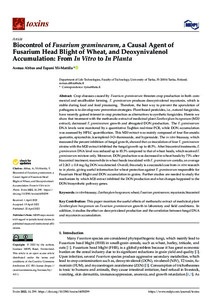| dc.contributor.author | Yli-Mattila Tapani | |
| dc.contributor.author | Abbas Asmaa | |
| dc.date.accessioned | 2022-10-28T12:25:55Z | |
| dc.date.available | 2022-10-28T12:25:55Z | |
| dc.identifier.uri | https://www.utupub.fi/handle/10024/159432 | |
| dc.description.abstract | <p>Crop diseases caused by <i>Fusarium graminearum</i> threaten crop production in both commercial and smallholder farming.<i> F. graminearum</i> produces deoxynivalenol mycotoxin, which is stable during food and feed processing. Therefore, the best way to prevent the sporulation of pathogens is to develop new prevention strategies. Plant-based pesticides, i.e., natural fungicides, have recently gained interest in crop protection as alternatives to synthetic fungicides. Herein we show that treatment with the methanolic extract of medicinal plant <i>Zanthoxylum bungeanum</i> (M20 extract), decreased <i>F. graminearum</i> growth and abrogated DON production. The <i>F. graminearum</i> DNA levels were monitored by a quantitative TaqMan real-time PCR, while DON accumulation was assessed by HPLC quantification. This M20 extract was mainly composed of four flavonoids: quercetin, epicatechin, kaempferol-3-O-rhamnoside, and hyperoside. The in vitro bioassay, which measured the percent inhibition of fungal growth, showed that co-inoculation of four <i>F. graminearum</i> strains with the M20 extract inhibited the fungal growth up to 48.5%. After biocontrol treatments,<i> F. graminearum</i> DNA level was reduced up to 85.5% compared to that of wheat heads, which received F. graminearum mixture only. Moreover, DON production was decreased in wheat heads by 73% after biocontrol treatment; meanwhile in wheat heads inoculated with F. graminearum conidia, an average of 2.263 ± 0.8 mg/kg DON was detected. Overall, this study is a successful case from in vitro research to in planta, giving useful information for wheat protection against F. graminearum responsible for Fusarium Head Blight and DON accumulation in grains. Further studies are needed to study the mechanism by which M20 extract inhibited the DON production and what changes happened to the DON biosynthetic pathway genes.<br></p> | |
| dc.language.iso | en | |
| dc.publisher | MDPI | |
| dc.title | Biocontrol of Fusarium graminearum, a Causal Agent of Fusarium Head Blight of Wheat, and Deoxynivalenol Accumulation: From In Vitro to In Planta | |
| dc.identifier.url | https://doi.org/10.3390/toxins14050299 | |
| dc.identifier.urn | URN:NBN:fi-fe2022081154024 | |
| dc.relation.volume | 14 | |
| dc.contributor.organization | fi=mat.-luonn.t. tdk yhteiset|en=Mat.-luonn.t. tdk yhteiset| | |
| dc.contributor.organization | fi=biokemia|en=Biokemia| | |
| dc.contributor.organization | fi=molekulaarinen kasvibiologia|en=Molekulaarinen kasvibiologia| | |
| dc.contributor.organization-code | 2606000 | |
| dc.contributor.organization-code | 2610101 | |
| dc.converis.publication-id | 175677604 | |
| dc.converis.url | https://research.utu.fi/converis/portal/Publication/175677604 | |
| dc.identifier.eissn | 2072-6651 | |
| dc.identifier.jour-issn | 2072-6651 | |
| dc.okm.affiliatedauthor | Yli-Mattila, Tapani | |
| dc.okm.affiliatedauthor | Abbas, Asmaa | |
| dc.okm.affiliatedauthor | Dataimport, 2610104 molekulaarinen kasvibiologia | |
| dc.okm.discipline | 1182 Biochemistry, cell and molecular biology | en_GB |
| dc.okm.discipline | 1183 Plant biology, microbiology, virology | en_GB |
| dc.okm.discipline | 1182 Biokemia, solu- ja molekyylibiologia | fi_FI |
| dc.okm.discipline | 1183 Kasvibiologia, mikrobiologia, virologia | fi_FI |
| dc.okm.internationalcopublication | not an international co-publication | |
| dc.okm.internationality | International publication | |
| dc.okm.type | Journal article | |
| dc.publisher.country | Switzerland | en_GB |
| dc.publisher.country | Sveitsi | fi_FI |
| dc.publisher.country-code | CH | |
| dc.relation.articlenumber | 299 | |
| dc.relation.doi | 10.3390/toxins14050299 | |
| dc.relation.ispartofjournal | Toxins | |
| dc.relation.issue | 5 | |
| dc.year.issued | 2022 | |
